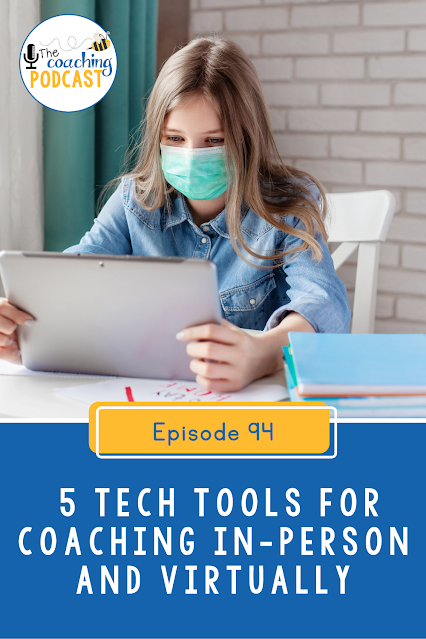The theme this month on The Coaching Podcast is virtually in-person. We've been talking about how to use the technology that came from virtual learning to impact in-person learning.
I don’t believe that virtual learning is the best mode of learning for our kids or teachers all the time. Going remote was done out of necessity. But there were some positive things that educators learned as a result, and we don’t want to lose that.
During this episode, I share five tech tools for coaching in-person and virtually. These are the online tools I fell in love with during remote teaching. In this blog, I’ll give you a few ideas from the show for how instructional coaches can use them with teachers. If you want to hear all my tips and tricks listen to the episode using the media player below.
Tech Tools for Coaching In-Person and Virtually
Here are my five favorite tech tools and some ways to use them when coaching. I also have a nifty little handout that includes these five tools and specific ideas for how to use them. You can get it by entering your email down below.
1. Google Forms
My first recommendation is something that most people already know about, but I think it's so valuable. There are lots of reasons I love Google Forms, including how easy they are to create and customize. They’re convenient to use and the results are attached to a Google sheet, so you can easily see responses.
One way I use Google Forms is to survey teachers You can ask them what type of PD support they want and plan around those themes. After a PD, send teachers a post professional development survey. The results will show you how they felt about the PD, what they learned, and how they're going to integrate the learning in their classroom.
2. Mentimeter
Mentimeter is a fun interactive tool that can be used to get responses from teachers. There are different things you can do with it like create graphs and word clouds using teacher answers.
With the scale feature, you choose statements and teachers decide whether they agree, disagree, or fall somewhere in the middle. If you do an activation guide, teachers can select how they feel about different statements before and after the PD to identify the impacts of the learning.
3. Flipgrid
Flipgrid is a cool way for people to create videos and respond to each other. It's useful for team building and a ton of other purposes.
The reason that I love Flipgrid is that you can create a stimulus video and have people respond to it. Teachers can interact with each other which creates an authentic dialogue.
One of my favorite ways to use Flipgrid is for book studies. Teachers are busy and don’t always have time to get together to talk. They can use Flipgrid to share their reflections and have a dialogue about the book.
4. Calendly
Calendly is an online calendar tool. You set your available hours and have teachers sign up for a time that works for them. It’s an easy way to give people access to the times you have available, so you don't have to email back and forth. The paid version even sends automated emails to remind people of the meetings.
I like to use Calendly for documentation. If you need to show the support you've provided to teachers, you can show your calendar. You can also use the calendar to explain where your time is going each day. It can help you advocate for your time when you get asked to take on a new task or do something outside of your normal scope of work.
5. Voxer
I was introduced to Voxer by my Coffee and Coaching partner, Nicole S. Turner. It's an app that you can download on your phone and use to communicate with groups of people.
One of the biggest problems with text messages and emails is that it can be hard to determine the tone of written words. Things can be interpreted differently depending on who's reading the message and their mindset at that moment. The best way to make sure people understand your tone is to say it, instead of writing it.
Voxer allows you to send voice memos and shows you when each person has listened to them. It's great for PLCs or teams of teachers working on a project.
Final Thoughts on Tech Tools for Coaching In-Person and Virtually
There you have it! Five of my favorite tech tools for coaching in-person and virtually. Listen to the entire episode to hear all my suggestions and learn about the bonus tool I mention on the show.
Don’t forget to sign up below for my free handout that lists all five tools and practical ideas for how to use them when coaching teachers.
Ready to listen? You can listen below with the media player, or search for Buzzing with MS. B: The Coaching Podcast anywhere you listen to podcasts!
Check me out at buzzingwithmsb.com and on Instagram @buzzingwithmsb.
Podcast produced by Fernie Ceniceros of Crowd & Town Creative


